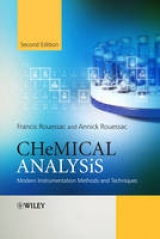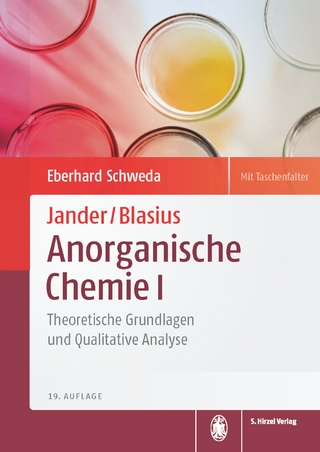
Chemical Analysis
John Wiley & Sons Ltd (Verlag)
978-0-471-98137-4 (ISBN)
- Titel erscheint in neuer Auflage
- Artikel merken
Chemical Analysis is an essential introduction to a wide range of analytical techniques and instruments. Assuming little in the way of prior knowledge, this text carefully guides the reader through the more widely used and important techniques, whilst avoiding excessive technical detail. Covering both instrumental techniques and the situations in which they are used, the text always strives to maintain a balance between breadth and depth of coverage. Carefully structured, this book clearly differentiates between separation and spectral methods, and includes a section on more specialised techniques. Chemical Analysis Provides a through introduction to a wide range of the most important and widely used instrumental techniques. Maintains a careful balance between depth and breadth of coverage. Includes many examples, problems and their solutions. Chemical Analysis will be invaluable to those studying or using instrumental techniques throughout the sciences, medicine and engineering.
Foreword to the French edition Foreword to the English edition Preface to the French edition Preface to the English edition Acknowledgements Introduction Part 1 Separation Methods Chapter 1 General aspects of chromatography 1.1 General concepts of analytical chromatography 1.2 Classification of chromatographic techniques 1.3 The chromatogram 1.4 The ideal chromatogram and Gaussian peaks 1.5 Real peaks 1.6 The theoretical plate model 1.7 Column efficiency 1.8 Retention parameters 1.9 Separation factor between two solutes 1.10 Resolution Factor between two peaks 1.11 The van Deemter equation in gas chromatography 1.12 Optimisation of a chromatographic analysis Problems Chapter 2 Gas chromatography 2.1 Components of a gas chromatograph 2.2 Carrier gas and flow regulation 2.3 Sample introduction and the injection chamber 2.4 Oven 2.5 Columns 2.6 Stationary phases (liquid type) 2.7 Stationary phases (solid type) 2.8 Common detectors 2.9 Detectors yielding structural information Appendix - Retention indices and constants related to stationary phases 2.10 Kovats relationship 2.11 Kovats retention indices 2.12 Stationary phase constants Problems Chapter 3 High performance liquid chromatography 3.1 Origin of HPLC 3.2 General scheme of an HPLC system 3.3 Pumps and gradient elution 3.4 Injectors 3.5 Columns 3.6 Stationary phases 3.7 Mobile phases 3.8 Chiral chromatography 3.9 Principal detectors 3.10 Applications Problems Chapter 4 Ion chromatography 4.1 The principle of ion chromatography 4.2 Mobile phases 4.3 Stationary phases 4.4 The principle of separation 4.5 Conductivity detectors 4.6 Ion suppressors Appendix - Quantitative analysis by chromatography 4.7 Principle and basic equation 4.8 Recording integrators and data treatment software 4.9 External standard method 4.10 Internal standard method 4.11 Internal normalisation Problems Chapter 5 Planar chromatography 5.1 Planar chromatography: principles of application 5.2 Post-chromatography: development of the plate 5.3 Stationary phases 5.4 Retention and separation parameters 5.5 Quantitative TLC 5.6 Aspects of TLC Problems Chapter 6 Supercritical fluid chromatography 6.1 Supercritical fluids 6.2 Supercritical phases as mobile phases 6.3 Comparison of SFC with HPLC and GC 6.4 Instrumentation 6.5 SFC in chromatographic techniques Chapter 7 Size exclusion chromatography 7.1 The principle of SEC 7.2 Stationary phases 7.3 Instrumentation 7.4 Domains of application Problems Chapter 8 Capillary electrophoresis 8.1 Zone electrophoresis 8.2 Free solution capillary electrophoresis 8.3 Electrophoretic mobility and electro-osmotic flow 8.4 Instrumentation and techniques 8.5 Indirect detection 8.6 Performance of capillary electrophoresis Problems Part 2 Spectroscopic Methods Chapter 9 Nuclear magnetic resonance spectroscopy 9.1 General description 9.2 Spin/magnetic field interaction for a nucleus 9.3 Nuclei that can be studied by NMR 9.4 Bloch's theory for a nucleus of I = 1/2 9.5 Larmor's frequency 9.6 Chemical shift 9.7 The principle of obtaining an NMR spectrum 9.8 Relaxation processes 9.9 The measurement of chemical shifts 9.10 Shielding and deshielding of the nuclei 9.11 Factors influencing chemical shifts 9.12 Hyperfine structure: spin/spin coupling 9.13 Heteronuclear coupling 9.14 Homonuclear coupling 9.15 Spin decoupling and modes of operation 9.16 Fluorine and phosphorous NMR Appendix - Quantitative NMR 9.17 Measurement of area - application to simple analysis 9.18 Samples containing compounds that can he identified 9.19 Internal standard method 9.20 Standard additions method 9.21 Analysers using pulsed NMR Problems Chapter 10 Infrared spectroscopy 10.1 Spectral representation in the mid infrared (IR) 10.2 Origin of absorption bands in the mid infrared 10.3 Rotational-vibrational bands in the mid infrared 10.4 Simplified model for vibrational interactions 10.5 Real model for vibrational interactions 10.6 Rotational bands of compounds in the gas phase 10.7 Characteristic bands for organic compounds 10.8 Instrumentation 10.9 Optics, sources and detectors used in the mid infrared 10.10 Sample analysis techniques 10.11 Infrared microscopy 10.12 Archiving spectra 10.13 Comparison of spectra 10.14 Calibration of cell thickness 10.15 Raman diffusion Problems Chapter 11 Ultraviolet and Visible absorption spectroscopy 11.1 General concepts 11.2 Molecular absorptions 11.3 Origin of absorption in relation to molecular orbitals 11.4 Donor-acceptor association 11.5 Isolated chromophores 11.6 Solvent effects: solvatochromism 11.7 Chromophores in conjugated systems 11.8 Woodward-Fieser rules 11.9 UV/Visible spectrophotometers 11.10 Quantitative analysis in the UV/Visible 11.11 Beer - Lambert's law 11.12 Visual colorimetry 11.13 Absorbance measurements 11.14 Confirmation analysis (purity control) 11.15 Distribution of relative errors due to instruments 11.16 Baseline correction 11.17 Multicomponent analysis (MCA) 11.18 Derivative spectrometry Problems Chapter 12 Fluorimetry 12.1 Fluorescence and phosphorescence 12.2 Origin of fluorescence 12.3 Fluorescence intensity 12.4 Rayleigh and Raman bands 12.5 Instrumentation 12.6 Applications 12.7 Chemiluminescence Problems Chapter 13 X-ray fluorescence spectrometry 13.1 General principle 13.2 X-ray fluorescence spectrum 13.3 Excitation modes of elements in X-ray fluorescence 13.4 X-ray absorption 13.5 Sample preparation 13.6 Different types of instruments 13.7 Quantitative analysis by X-ray fluorescence 13.8 X-ray fluorescence applications Problems Chapter 14 Atomic absorption and flame emission spectroscopy 14.1 Principles common to the two methods 14.2 Interpretation of the phenomena involved 14.3 Atomic absorption vs flame emission 14.4 Measurements by absorption or flame emission 14.5 Basic instrumentation for atomic absorption 14.6 Flame photometers 14.7 Correction of interfering absorptions 14.8 Physical and chemical interferences 14.9 Sensitivity and detection limits in AAS Problems Chapter 15 Atomic emission spectroscopy 15.1 Optical emission spectrophotometry (OES) 273 15.2 Excitation by inductively coupled plasma (ICP) 15.3 Ionisation by arc, spark or electronic impact 15.4 The principles of atomic emission analysis 15.5 Spectral lines 15.6 Simultaneous and sequential instruments 15.7 Performance 15.8 GC coupled to atomic emission relatively 15.9 Applications of atomic emission spectrometry Problems Part 3 Other Methods 287 Chapter 16 Mass spectrometry 16.1 Principles 16.2 The Bainbridge spectrometer 16.3 Magnetic analysers (EB type) 16.4 Time of flight (TOF) analysers 16.5 Ion cyclotron resonance 16.6 Quadrupole analysers 16.7 Ion traps 16.8 Performance of mass spectrometers 16.9 Sample introduction 16.10 Major ionisation techniques (under vacuum) 16.11 Atmospheric pressure ionisation (API) 16.12 Ion detection 16.13 Tandem mass spectrometry Appendix - Applications in mass spectrometry 16.14 Determination of empirical formulae 16.15 Determination of isotope ratios for an element 16.16 Identification using spectral libraries 16.17 Fragmentation of organic ions Problems Chapter 17 Labelling methods 17.1 Principle of labelling methods 17.2 Isotopic dilution with a radioactive label 17.3 Measurement of radioisotope activity 17.4 Choice of a sub-stoichiometric method 17.5 Labelling with stable isotopes 17.6 Immunoenzymatic (IEA) methods of measurement 17.7 Other immunoenzymatic techniques 17.8 Advantages and limitations of the ELISA test in chemistry 17.9 Radio-immunoassay (RIA) 17.10 immunofluorescence assay (IFA) 17.11 Neutron activation analysis (NAA) 17.12 Thermal neutrons 17.13 Induced activity - irradiation time 17.14 Detection by gamma-counting - measurement principle 17.15 Applications Problems Chapter 18 Potentiometric methods 18.1 General principles 18.2 A particular ion selective electrode: the pH electrode 18.3 Ion selective electrodes 18.4 Calculations and different methods 18.5 Applications Problems Chapter 19 Coulometric and voltammetric methods 19.1 General principles 19.2 Dropping-mercury electrode 19.3 Continuous current polarography 19.4 Diffusion current 19.5 Pulse polarography 19.6 Amperometric detection in HPLC and CE 19.7 Special sensors 19.8 Stripping voltammetry 19.9 Coulometric measurements 19.10 Karl Fischer coulometric determination of water 19.11 Determination by the Karl Fischer method Problems Chapter 20 Some sample preparation methods 20.1 Evolution of methods 20.2 Solid-phase extraction using columns or discs 20.3 Gas-solid extraction using columns or discs 20.4 Headspace sample analysis 20.5 Supercritical fluid extraction (SFE) 20.6 Mineralisation by microwave digestion Chapter 21 Basic statistical parameters 21.1 Mean value and accuracy 21.2 Precision and standard deviation of a group of results 21.3 Indeterminate or random errors 21.4 Confidence interval 21.5 Parametric tests - comparison of results 21.6 Rejection criteria - Q test (Dixon test) 21.7 Linear regression 21.8 Robust methods 21.9 Method optimisation using factorial analysis Problems Solutions Appendix - List of acronyms Bibliography Table of physico-chemical constants Index
| Erscheint lt. Verlag | 17.4.2000 |
|---|---|
| Zusatzinfo | Illustrations |
| Verlagsort | Chichester |
| Sprache | englisch |
| Maße | 172 x 251 mm |
| Gewicht | 910 g |
| Einbandart | gebunden |
| Themenwelt | Naturwissenschaften ► Chemie ► Analytische Chemie |
| Naturwissenschaften ► Chemie ► Anorganische Chemie | |
| ISBN-10 | 0-471-98137-0 / 0471981370 |
| ISBN-13 | 978-0-471-98137-4 / 9780471981374 |
| Zustand | Neuware |
| Haben Sie eine Frage zum Produkt? |
aus dem Bereich



